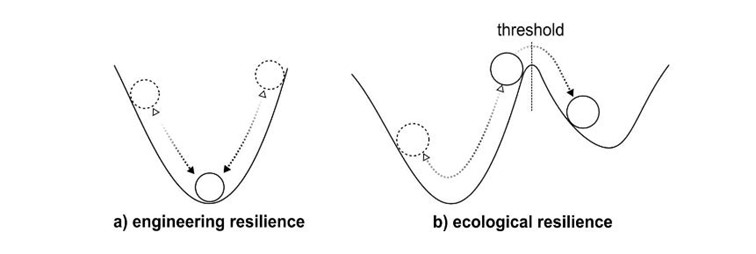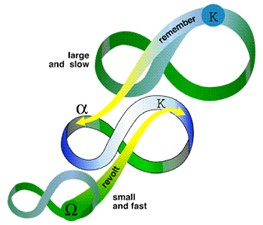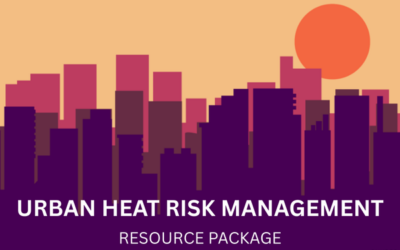Resilience
For some years now, the term ‘resilience’ has been used in many areas of society dealing with disaster risk reduction, sustainable development and adaptation to climate change.
But what exactly is resilience and is it more than just a fashionable term?
© Pixabay
History and concepts
The term ‘resilience’ comes from the Latin (resilire) and means to bounce back or rebound (Thun-Hohenstein et al., 2020). Accordingly, the term was initially used in the early 19th century in material sciences and referred to the ability of materials to absorb deformations without becoming permanently deformed (Sudmeier-Rieux, 2014).
Since the 1970s, psychological research has taken up the concept of resilience (Block and Block, 1977), among other things to describe the ability of people to recover from traumatic events (Nutting and Norris, 1968; Werner, 1989).
Resilience’ gained great importance in ecosystem research. Initially, the focus was on so-called ‘engineering resilience’ (Holling, 1973; Hollnagel et al., 2006), which describes the ability of ecosystems to cope with and survive external stress. Changes in the overall system can throw the ecosystem (‘the sphere’) out of balance. Similar to, for example, a lake that eventually ‘tips over’ due to continuous discharge of wastewater. Resilience here therefore refers to the resilience of the lake ecosystem to external influence (i.e., contamination from the effluents).
Figure 1: Engineering and ecological resilience (Hoang et al., 2017).
However, as (eco)systems can have several, different states of equilibrium, the idea of ‘engineering resilience’ has been extended to ‘ecological resilience’ (Holling, 1973; Hollnagel et al., 2006). This is based on the understanding that a system can have several stable states. Thus, the recovery of an ecosystem does not necessarily mean a return to the initial conditions.
This understanding of resilience was later extended to social-ecological systems, thus providing a conceptual framework of nested systems interacting across scales (so-called panarchy) (Holling and Gunderson, 2002; Folke, 2006). A strong focus is placed on the transformations and interactions of systems across scales. They grow, mature, collapse, renew themselves and in the process continually open new ”windows of opportunities”. Resilience is understood here rather as an ongoing process of transformation and adaptation, also enabled by learning, and remembering from past transformations.
Figure 2: Panarchy (Source: Resilience Alliance, 2023).
Resilience at the international level
Today, resilience has become the guiding principle and explicit goal of several international frameworks, such as the Sustainable Development Goals (SDGs) (United Nations, 2015a), the Paris Climate Agreement on climate change (United Nations, 2015b), the Sendai Framework for Disaster Risk Reduction 2015 – 2030 (UNDRR, 2015) and the New Urban Agenda (UN Habitat, 2016). The underlying resilience definitions differ in these frameworks. However, there are efforts to unify the respective understandings of resilience (UNDP, 2020):
Definition resilience
‘the ability of individuals, households, communities, cities, institutions, systems and societies to prevent, resist, absorb, adapt, respond and recover positively, efficiently and effectively when faced with a wide range of risks, while maintaining an acceptable level of functioning without compromising long-term prospects for sustainable development, peace and security, human rights and well-being for all.’ (UNDP, 2020)
In addition, this report suggest five capacities which form the basis of a system’s resilience:
Build back better
This understanding of resilience goes far beyond the original meaning in terms of robustness and resistance, especially by emphasising the aspects of transformation and learning capacity. This thematically ties in with the Build Back Better concept, which calls for the reconstruction phase after a disaster event not to be used to restore old structures, but instead to establish more resilient systems.
Absorptive capacity
The ability to take protective action and ‘bounce back’ after a shock using predetermined responses to preserve and restore essential basic structures and functions. It involves anticipating, planning, coping and recovering from shocks and stresses.
Adaptive capacity
The ability to make incremental adjustments, modifications or changes to the characteristics of systems and actions to moderate potential changes, in order to continue functioning without major qualitative changes in function or structural.
Anticipative capacity
The ability to take early action in anticipation of a potential threat to reduce its potential negative impacts; including through early warning, early action and forecast-based financing
Preventive capacity
The ability to implement activities and take measures to reduce existing risks and avoid the creation of new risks. While certain risks cannot be eliminated, preventative capacity aims at reducing vulnerability and exposure in such contexts where, as a result, the risk is reduced
Transformative capacity
The ability to create a fundamentally new system when ecological, economic or social structures make the existing system untenable. Transformative capacity is required when the change needed goes beyond the system’s anticipatory, absorptive, adaptive and preventative abilities and when there is recognition that ecological, economic or social structures keep people trapped in a vicious circle of poverty, disasters and conflict and make the existing system unsustainable.
Resilience At THE National Level
Resilience in Germany
In Germany, too, resilience is increasingly seen as a central concept for risk-informed, climate-adapted, and sustainable development. A national resilience strategy was developed by an interministerial working group and adopted by the Bundestag in summer 2022. The Federal Foreign Office (AA), the Federal Ministry for Economic Cooperation and Development (BMZ), the Federal Ministry for the Environment, Nature Conservation and Nuclear Safety (BMU), the Federal Ministry of the Interior, for Construction and Home Affairs (BMI), the German Red Cross (DRK), the Deutsche Gesellschaft für Internationale Zusammenarbeit (GIZ) GmbH and the Federal Office of Civil Protection and Disaster Assistance (BBK) are involved in this. Coordination was carried out by the National Contact Point of the Sendai Framework at the Federal Office of Civil Protection and Disaster Assistance.
Resilience at the DKKV
For the DKKV, strengthening societal resilience is the central guiding principle (Strategy 2030+). Just as resilience implies a wide range of concepts and measures to explore and better understand the dynamics in socio-ecological systems, the approaches to strengthening resilience are also diverse. Several of the DKKV’s current activities and projects aim to increase resilience, for example through knowledge transfer between actors from science, operational practice, and politics. In the MYrisk project, municipal decision-makers in particular should benefit from an exchange of best practices. In the project on resilience in tourism, we analysed how resilience could be made measurable for tourism destinations and proposals for compensating for resilience deficits were made.
Created: October 2021; updated February 2023
Additional Links
DKKV

Project - Resilience in tourism
Further Information

Sendai Framework for disaster risk reduction
Current Information
Once Extreme, Now Normal
A recent report published in the Behörden Spiegel (German Public Sector Journal) warns of the growing dangers posed by climate change - in particular, the creeping normalization of extreme weather events such as heatwaves, droughts, and heavy rainfall. Experts from...
Extreme heat in cities: New UN resource package to support cities
The number and intensity of heatwaves in cities is increasing worldwide - with sometimes dramatic consequences for health, infrastructure and the environment. In order to better prepare cities for this growing challenge, the UN initiative Making Cities Resilient 2030...
The role of women in adapting to climate change
Women are around 14 times more likely to die in droughts, floods or other disaster events than men. Women in Africa or South Asia in particular usually have fewer resources than men and religious norms, lower income and lack of education contribute to their exposure...







